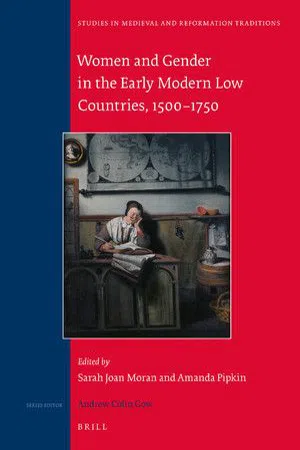
- English
- PDF
- Available on iOS & Android
Women and Gender in the Early Modern Low Countries, 1500-1750
About this book
Women were fundamental actors in early modern Low Countries society, playing major roles in the dynamic environment of economic, artistic, and cultural exchange of both the Catholic Southern Netherlands and the Protestant Dutch Republic.The Habsburg territories were governed by a string of women rulers. More ordinary Netherlandish women ran businesses, pursued careers as painters and writers, joined and led religious communities, and helped steer the course of debates between Protestants and Catholics. The wealthier among them were active in the financial markets and a number of them became highly influential patrons of art and architecture. Women of lesser means, on the other hand, might find themselves in difficult situations. At the same time, evolving traditions of the textual and visual representation of femininity reflected and shaped attitudes towards gender, and in turn impacted the lives of both women and men.
Frequently asked questions
- Essential is ideal for learners and professionals who enjoy exploring a wide range of subjects. Access the Essential Library with 800,000+ trusted titles and best-sellers across business, personal growth, and the humanities. Includes unlimited reading time and Standard Read Aloud voice.
- Complete: Perfect for advanced learners and researchers needing full, unrestricted access. Unlock 1.4M+ books across hundreds of subjects, including academic and specialized titles. The Complete Plan also includes advanced features like Premium Read Aloud and Research Assistant.
Please note we cannot support devices running on iOS 13 and Android 7 or earlier. Learn more about using the app.
Information
Table of contents
- Contents
- Acknowledgments
- Figures
- Notes on Contributors
- Introduction
- Chapter 1 The Problem of Women’s Agency in Late Medieval and Early Modern Europe
- Chapter 2 Women’s Writing during the Dutch Revolt: the Religious Authority and Political Agenda of Cornelia and Susanna Teellinck, 1554–1625
- Chapter 3 The Maid of Holland and Her Heroic Heiresses
- Chapter 4 The Absent Made Present: Portraying Nuns in the Early Modern Low Countries
- Chapter 5 Women Writers and the Dutch Stage: Public Femininity in the Plays of Verwers and Questiers
- Chapter 6 Anna Francisca de Bruyns (1604/5–1656), Artist, Wife and Mother: a Contextual Approach to Her Forgotten Artistic Career
- Chapter7 Foregrounding the Background: Images of Dutch and Flemish Household Servants
- Chapter 8 Resurrecting the ‘Spiritual Daughters’: the Houtappel Chapel and Women’s Patronage of Jesuit Building Programs in the Spanish Netherlands
- Index